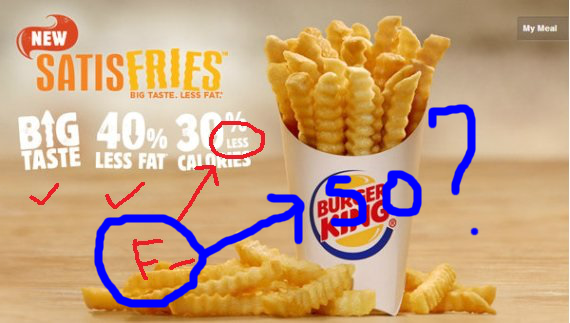
On January 7, novelist Fiona Maazel posted an article in The Millions decrying “the depredation of our culture” at the hands of advertising copywriters who mangle the English language. In her headline example, illustrated by a marked-up reproduction of a Burger King ad for a new line of French fries called “Satisfries,” Maazel pointed out that the ad’s copywriters used the phrase “30% less calories” when the correct usage should be “30% fewer calories.”
Maazel’s piece, “Commercial Grammar,” was quickly picked up on Facebook, Twitter, and Reddit, and within hours, it had gone viral. Let’s set aside for a moment the hair-splitting debates that filled the comments section of Reddit about whether, in certain contexts, “calories” could be considered a mass rather than a countable number, and thus could be correctly modified by “less” rather than “fewer.” Let’s also set aside the question of whether we should expect correct grammar from an ad describing a food product called “Satisfries.” Instead, let’s look at the more perplexing question of why tens of thousands of people seem to care so fervently about the correctness of the grammar in their burger ads.
At the heart of disputes over articles like Maazel’s is the age-old lexicographical debate between Prescriptivists, who believe the English language has a single important set of rules that should be rigorously enforced, and Descriptivists, who see language as an ever-shifting mode of human expression that can be described but not regulated. But this argument, which tends to suck up all the oxygen in any lexicographical debate, ignores the more important reality that, in many ways, both sides are right. There is a standard version of written English, whose rules are both well codified and remarkably stable. At the same time, there are as many versions of English as there are communities speaking and writing English, and all of them are forever inventing new words and new grammatical constructions and toying with new ways to use old words and constructions.
What is new, or at least newish, is the degree of contact between these two strains of the language in the public sphere. For much of the history of English, formal language used by educated elites and the vernacular English used by the masses operated in largely separate spheres. For several hundred years, following Franco-Norman King William the Conqueror’s invasion of Britain in 1066, the ruling elites literally used a different language – French – from their English-speaking subjects. Even once British kings began using English again in the 1400s, many formal documents were written in Latin, and the documents themselves did not circulate widely because printing technologies were primitive and most speakers of English were illiterate.
Only in the modern era, as literacy has risen and publication has become faster and cheaper, have the elite and the hoi polloi had to share a common language in public discourse. Interestingly, while all writing, like all culture, has seen a gradual shift toward the casual, the basic grammar of standard written English has changed very little, according to linguist Alexandra D’Arcy, an expert on contemporary English usage at the University of Victoria in Canada. “Standard written English is really stable,” she explains. “It’s codified. It’s all written down.”
But if standard written English – the version of English taught in most college composition classes – remains stable, technological change has brought vernacular English into the public sphere in the form of newspapers, television, blog posts, and, yes, advertising. Thus, what may seem to some like a frontal attack on the ancient and venerated form of standard written English is in fact something quite different: a rise of a new public language heavily influenced by oral speech and consumer culture that, supercharged by online and television discourse, does much of the actual persuading in modern life while leaving standard, university-taught English largely unscathed.
In other words, yes, the barbarians have breached the gates, and at least in terms of advertising and broadcast discourse, they are indeed driving the cultural conversation. This, however, has not come at the expense of standard written English, which remains the prime mode of communication for the educated elite. If you want to sell French fries, you can safely confuse “less” and “fewer.” On the other hand, if you are writing to an educated reader in a formal context – an English paper, say, or a business letter – even a few minor errors of grammar or style will place you at the wrong end of a class and educational continuum, which by itself may well torpedo your argument, whatever its other merits.
One need not be a linguist to see these forces in action. I’ve taught college composition on and off for nearly twenty years and took composition courses myself in college thirty years ago, and nothing about the language I teach in 2014 is significantly different from the English I was taught in the 1980s. This fact is all the more remarkable when one considers the staggering technological change that has occurred in that time. I hauled a typewriter to college all four years, and I was fairly unusual back then in that I could touch-type; most of my fellow students wrote their papers in longhand and either typed up their final drafts or paid someone else to do it. By the same token, when my professors asked me to do research, I had to go to the library and look things up in the ancient, and for me at least, incomprehensible card catalog.
Today, in an age of smartphones and iPads, it is rare to find a college student who can’t touch-type, and research that would have taken me weeks in the 1980s can now be accomplished in minutes. This has had an enormous impact on how students write and research college papers – and fostered a genuine epidemic of plagiarism in the academy – but, oddly, it has had little effect on the language my students use. My students may spend their idle hours on smartphones checking Facebook and shooting off texts to each other, but never once, in all my years of teaching, has a student spelled “you” as “u” or “before as “b4”.
This may seem both a trivial and obvious observation, but it helps explain how it can be that while public discourse is forever shifting, the rules of standard written English remain so stable. Put simply: people understand context, and if they are given the tools, they can tailor their language to their audience. So it is that those same students texting snarky little shards of language to their friends on their phones can hand me papers written in fully grammatical sentences, with the verbs properly conjugated and (okay, most of) the words spelled correctly.
The key phrase here is: if they are given the right tools. As a man who has spent much of his adult life on the front lines in the war on bad undergraduate prose, I cannot begin to tell you how rare it is to find a student who walks into college the first day writing well. It happens, but it’s a moment to be savored, like sighting a bald eagle in the wild. Nor can most college freshmen use “who” and “whom” correctly, or for that matter, tell the difference between “less” and “fewer.” This is not because today’s college students are stupid or lazy, or because our literary culture is collapsing around us, but because the grammar and rhetoric of written English, unlike those of the spoken English we acquire as toddlers, are artifacts of education.
Which, in a roundabout way, brings us back to the Burger King ad. To D’Arcy’s expert eye, there are any number of possible reasons why the copywriters misused “less” in the “Satisfries” ad, but one of them is that most people simply wouldn’t notice. After all, she notes, nobody complains about supermarket express lines that restrict shoppers to “ten items or less.” “Even I don’t get up in arms about that,” she says. “And, yes, I do pick it out in student writing, but not in speech.”
Therein lies an important distinction. One of the very hardest things to teach fledgling writers to do is to be precise in their prose. Again, this isn’t because they are morons, or because we are suffering a culture-wide epidemic of vagueness, but because people who don’t write a lot naturally fall back on the grammar and rhetoric of speech, and in speech you can be much more sloppy. In speech, it doesn’t matter whether you use “less” or “fewer” to refer to the items in your cart because the items are right there in your cart where both the speaker and listener can see them. It’s only important to differentiate between mass and count when you can’t see the things you’re talking about – that is, when you’re writing and your audience is reading.
It may well be that for most viewers of the “Satisfries” ad, the words are written but “read” as speech. Most print ads are like this. You read the words, but in your head you hear some silver-tongued huckster – or alternatively, some sultry beauty – saying them aloud. As an English prof, I would mark a misused “less” every time, but it wouldn’t occur to me to do so in a print ad because an ad operates by different rules, the rules of oral speech.
The thing is, people pay top dollar – upwards of $50,000 a year at Fordham University, the last place I taught – to have professors like me help them shed the habits of a lifetime of spoken English and learn the subtle folkways of standard written English, which remain a ticket to mainstream economic success. Of course, this transition is harder to pull off if the language you grew up speaking is radically different from standard written English. I am a child of the professional class, so the English I spoke at the dinner table as a child differs only at the margins from the language I teach my students. But if my parents had never finished high school, or if they were immigrants whose English was iffy, my journey to flawless written English would have required a great deal more work and raw brain power.
Therein lies the danger of equating the status of standard written English with the health of the culture as a whole. For one thing, as I’ve tried to demonstrate above, standard written English is doing just fine. More importantly, the language we use is an indelible marker for everything about us from our social class and ethnic origin to our race and educational history. We all know this. It’s how we pick out scam emails from real ones. You can fake URLs and corporate logos, but a non-agreeing subject and verb will give you away every time.
The ugly inverse of this is that discussion of English usage can serve as a safe way to touch the third rail of American public discourse, which is open discussion of race and social class. It is an unforgivable offense to publicly criticize another American’s race or class background, but one can safely condemn another person’s “improper” use of English because, well, there are rules and this person’s prose violated them.
We feel safe discussing English usage in terms of “right” and “wrong,” “proper” and “improper” because words aren’t people, but as D’Arcy points out:
When we talk about language, we’re really talking about speakers and specifically groups of speakers. It could be a group based on sex, gender and sexuality. It could be based on ethnicity. It could be based on language background. It could be based on economic and educational background. It could be based on region… Language is a huge proxy for identity. The way we talk says volumes about who we are and how we want to be perceived and how we view ourselves in fitting into our own cultures and our own groups.
Of course, there’s no way to know whether all those readers commenting on Maazel’s article last month were engaging in a coded discussion of race and class or merely taking part in a spirited debate over grammatical arcana. What is certain is that it is imperative for those of us in the educated elite – and if you’re here, chances are you are part of the educated elite – to be clear about what we’re discussing when we speak about standard written English. We are speaking about a language that is both thriving and powerful, and that many of us paid dearly to master. It is ideally suited to some linguistic tasks, such as reasoned argument and imaginative fiction, and perhaps less well suited to others, such as, say, advertising copy. But standard written English isn’t “right.” It isn’t “better.” It is merely one language among many.







